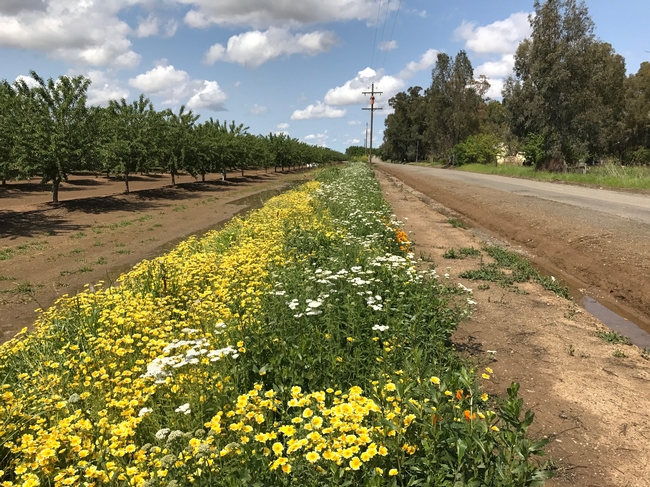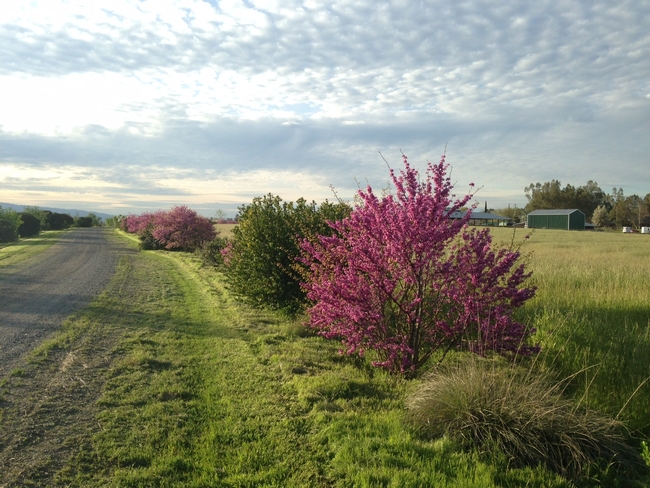Super blooms in the Central Valley: Why it’s not just about the color
Have you seen the blaze of super blooms popping up alongside orchards and field crops in our rich agricultural Central Valley? The corridors of poppies, tidy tips, yarrow, baby blue eyes, and redbud planted by farmers, dazzle us with color, but they serve a purpose, too.
The flowers provide nectar and pollen for the pollinators, including honey bees, bumble bees and carpenter bees. Look beyond the buzz, and you'll see other beneficial insects, such as lady beetles (ladybugs) and their larvae devouring aphids, and tiny parasitoid wasps preying on stinkbugs and armyworms. They're (unpaid) pest control agents at work.
Farmers are taking notice. Knowing that most beneficial insects rely on floral resources to survive and reproduce, they're bordering their field crops with strips of flowering plants. In addition to gaining pollination and pest control services, they're gaining financial benefits. University of California researchers documented that pest control and pollination benefits will help pay the cost of a 1,000-foot-long-flowering hedge planting within 7 to 16 years. Their research, Pest Control and Pollination Cost-Benefit Analysis of Hedgerow Restoration in a Simplified Agricultural Landscape, was published last year in the Journal of Economic Entomology.
Other benefits of field edge habitat plantings can include weed exclusion, air quality improvement, erosion reduction, wind protection, shade, and wildlife habitat.
What plants are best to attract beneficial insects to farms and gardens? The UC Statewide Integrated Pest Management Program (UC IPM) has just published a list of insectary plants on its website. The list includes native California perennial flowering shrubs and wildflowers suited for field-edge plantings.
UC IPM defines insectary plants as “those grown to attract, feed, and shelter insect parasites (parasitoids) and predators to enhance biological pest control. Insectary plants provide nectar and pollen for adult natural enemies to consume. Even if pests are abundant, certain natural enemies may be less abundant, shorter-lived, or produce fewer offspring unless nectar and pollen resources are available. Insectary plants can also host alternate prey that will feed the natural enemies and keep them abundant locally.”
Are you concerned about rodents and food safety issues from hedgerows plantings? Not to worry. A recent study by UC Agriculture and Natural Resources (UC ANR) researchers found minimal adverse influence on larger agricultural landscapes. A bonus: Migratory songbirds, like goldfinches, often seek out the seeds from the flowering plants in the hedgerows and offer their own display of color. What about weeds? Yes, they can be problematic. Be sure they're well-controlled before planting wildflowers; think soil solarization and herbicides.
Another UC ANR-associated study, Determinants of Field Edge Habitat Restoration on Farms in California's Sacramento Valley, published this year in the Journal of Environmental Management, found that landowners and farmers familiar with the benefits were more likely to adopt these small-scale habitat restoration plantings on their farms. Also important is technical support from agencies such as the USDA, UC Cooperative Extension Service, and the Xerces Society for Invertebrate Conservation, and the sharing of information from farmer-to-farmer and neighbor-to-neighbor.
Something else we can all do: Share your photos of field-edge habitat plantings and your observations on social media. They tell an important story and can inspire landowners to diversify farmlands. This will help drive home the point that providing flowers for beneficial insects, including bees and natural enemies, will build resilience in our farming systems. Natural pollination and pest control services help counter the disastrous effects of colony collapse disorder and other honey bee maladies, and pesticide resistance.
And it's a counter-punch of color.



